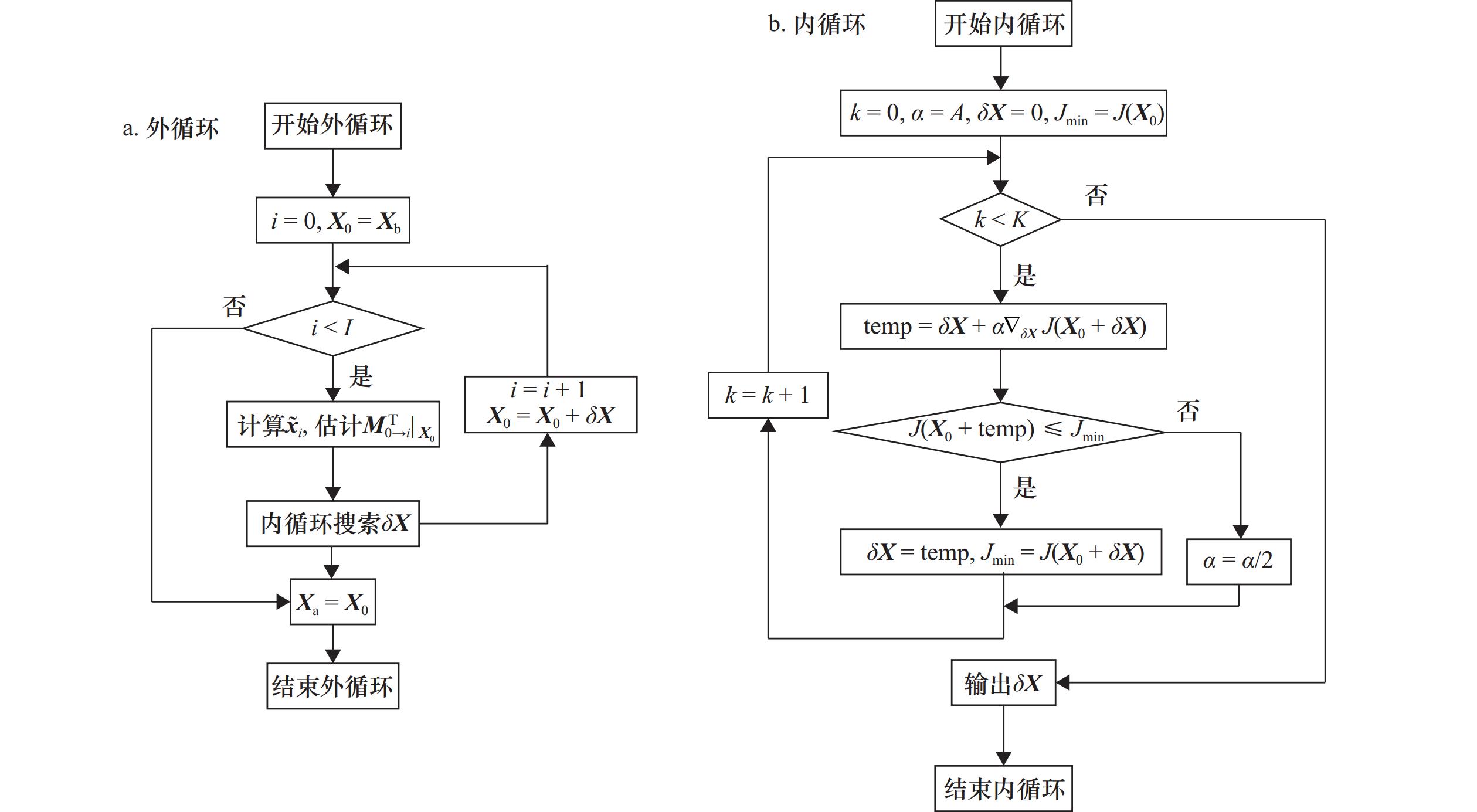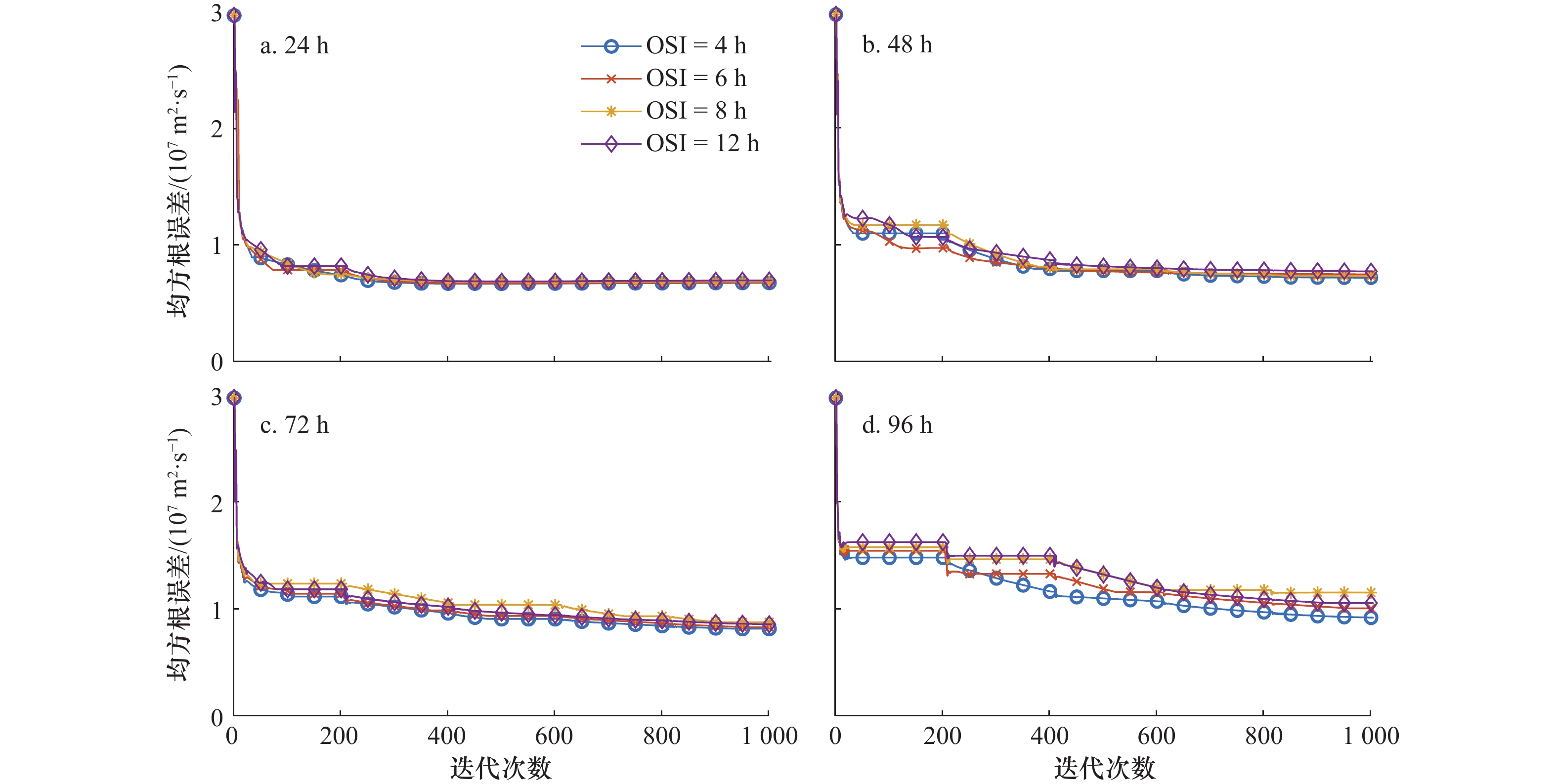Initial field optimization of Global Barotropic Model based on Analytical Four Dimensional Ensemble Variational
-
摘要: 解析四维集合变分数据同化方法是一种无需伴随的、完全继承四维变分非线性处理能力的、“流依赖”的非顺序数据同化方法。本研究基于解析四维集合变分,开展全球正压谱模式初始场优化研究,验证解析四维集合变分的同化能力,并构建了高效的扰动集合成员生成方案,将解析四维集合变分降维到了样本空间,最后检验了解析四维集合变分对同化积分窗口长度和观测采样间隔的敏感性。试验结果表明,解析四维集合变分能优化全球正压谱模式的初始场,降维到样本空间后,只需要80个集合成员就可以取得很好的同化效果,在较长的同化积分窗口和观测采样间隔的条件下也可以达到理想的同化效果。Abstract: The Analytical Four Dimensional Ensemble Variational is a “flow-dependent” and non-sequential data assimilation method without adjoint models and completely inherits the nonlinear processing ability of Four Dimensional Variational. In this study, based on the Analytical Four Dimensional Ensemble Variational, the initial field optimization of the Global Barotropic Model was carried out, the assimilation ability of Analytical Four Dimensional Ensemble Variational in the medium complex model was verified, the efficient perturbation ensemble member generation scheme was explored, and Analytical Four Dimensional Ensemble Variational was reduced to the sample space, and finally the sensitivity to the assimilation time window length and the observation sampling interval was verified. The experiments results show that the Analytical Four Dimensional Ensemble Variational can optimize the initial field of the Global Barotropic Model, and after reducing the dimensionality to the sample space, only 80 ensemble members are required to achieve good assimilation effect, and ideal assimilation can also be achieved under the conditions of a long assimilation integration window and observation sampling interval.
-
表 1 经验正交函数分解的累计方差占比
Tab. 1 Cumulative percentage of variance for EOF
模态数量 累计方差占比/% 20 76.2 40 83.9 60 88.0 80 90.7 100 92.6 表 2 A-4EnVar全球正压谱模式初始场优化试验设计
Tab. 2 Experiments design of Global Barotropic Model initial field optimization based on A-4EnVar
试验 变量替换方式 同化积分窗口长度/h 观测采样间隔/h 集合成员数量 是否降维 A $ {{\boldsymbol{B}}_{00}} $变换、$ {{\tilde{\boldsymbol x}}_0} $变换 24 6 3 456 否 B $ {{\tilde{\boldsymbol x}}_0} $变换 24 6 20、40、60、80、100 是 C $ {{\tilde{\boldsymbol x}}_0} $变换 24、48、72、96 4、6、8、12 80 是 表 3 收敛后A-4DEnVar目标函数和均方根误差减小的百分比(%)
Tab. 3 The reduction percentage of the cost function of A-4DEnVar and RMSE (%)
变量替换方式 目标函数 均方根误差 $ {{\boldsymbol{B}}_{00}} $变换 84.0 62.2 $ {{\tilde{\boldsymbol x}}_0} $变换 98.8 88.8 表 4 优化后目标函数和均方根误差减小的百分比(%)
Tab. 4 The reduction percentage (%) of the cost function and RMSE after optimization
集合成员数量 是否降维 目标函数 均方根误差 3456 否 98.8 88.8 100 是 94.8 78.3 80 是 94.2 77.1 60 是 92.9 75.2 40 是 88.8 68.6 20 是 85.3 64.7 -
[1] 吴新荣, 王喜冬, 李威, 等. 海洋数据同化与数据融合技术应用综述[J]. 海洋技术学报, 2015, 34(3): 97−103.Wu Xinrong, Wang Xidong, Li Wei, et al. Review of the application of ocean data assimilation and data fusion techniques[J]. Journal of Ocean Technology, 2015, 34(3): 97−103. [2] Hooghiemstra P B, Krol M C, Meirink J F, et al. Optimizing global CO emission estimates using a four-dimensional variational data assimilation system and surface network observations[J]. Atmospheric Chemistry and Physics, 2011, 11(10): 4705−4723. doi: 10.5194/acp-11-4705-2011 [3] Sugiura N, Awaji T, Masuda S, et al. Development of a four-dimensional variational coupled data assimilation system for enhanced analysis and prediction of seasonal to interannual climate variations[J]. Journal of Geophysical Research: Oceans, 2008, 113(C10): C10017. [4] Park S K, Županski D. Four-dimensional variational data assimilation for mesoscale and storm-scale applications[J]. Meteorology and Atmospheric Physics, 2003, 82(1/4): 173−208. [5] Hu Yiwen, Zang Zengliang, Ma Xiaoyan, et al. Four-dimensional variational assimilation for SO2 emission and its application around the COVID-19 lockdown in the spring 2020 over China[J]. Atmospheric Chemistry and Physics, 2022, 22(19): 13183−13200. doi: 10.5194/acp-22-13183-2022 [6] Elbern H, Schmidt H. Ozone episode analysis by four-dimensional variational chemistry data assimilation[J]. Journal of Geophysical Research: Atmospheres, 2001, 106(D4): 3569−3590. doi: 10.1029/2000JD900448 [7] Rihan F A, Collier C G, Roulstone I. Four-dimensional variational data assimilation for Doppler radar wind data[J]. Journal of Computational and Applied Mathematics, 2005, 176(1): 15−34. doi: 10.1016/j.cam.2004.07.003 [8] Wu C C, Chou K H, Wang Yuqing, et al. Tropical cyclone initialization and prediction based on four-dimensional variational data assimilation[J]. Journal of the Atmospheric Sciences, 2006, 63(9): 2383−2395. doi: 10.1175/JAS3743.1 [9] Gao Chuan, Wu Xinrong, Zhang Ronghua. Testing a four-dimensional variational data assimilation method using an improved intermediate coupled model for ENSO analysis and prediction[J]. Advances in Atmospheric Sciences, 2016, 33(7): 875−888. doi: 10.1007/s00376-016-5249-1 [10] Rawlins F, Ballard S P, Bovis K J, et al. The Met Office global four-dimensional variational data assimilation scheme[J]. Quarterly Journal of the Royal Meteorological Society, 2007, 133(623): 347−362. doi: 10.1002/qj.32 [11] Huang Xiangyu, Xiao Qingnong, Barker D M, et al. Four-dimensional variational data assimilation for WRF: formulation and preliminary results[J]. Monthly Weather Review, 2009, 137(1): 299−314. doi: 10.1175/2008MWR2577.1 [12] Peng S Q, Xie L. Effect of determining initial conditions by four-dimensional variational data assimilation on storm surge forecasting[J]. Ocean Modelling, 2006, 14(1/2): 1−18. [13] Meirink J F, Bergamaschi P, Krol M C. Four-dimensional variational data assimilation for inverse modelling of atmospheric methane emissions: method and comparison with synthesis inversion[J]. Atmospheric Chemistry and Physics, 2008, 8(21): 6341−6353. doi: 10.5194/acp-8-6341-2008 [14] Liu Chengsi, Xiao Qingnong, Wang Bin. An ensemble-based four-dimensional variational data assimilation scheme. Part I: technical formulation and preliminary test[J]. Monthly Weather Review, 2008, 136(9): 3363−3373. doi: 10.1175/2008MWR2312.1 [15] Liu Chengsi, Xiao Qingnong, Wang Bin. An ensemble-based four-dimensional variational data assimilation scheme. Part II: observing system simulation experiments with Advanced Research WRF (ARW)[J]. Monthly Weather Review, 2009, 137(5): 1687−1704. doi: 10.1175/2008MWR2699.1 [16] Liu Chengsi, Xiao Qingnong. An ensemble-based four-dimensional variational data assimilation scheme. Part III: Antarctic applications with Advanced Research WRF using real data[J]. Monthly Weather Review, 2013, 141(8): 2721−2739. doi: 10.1175/MWR-D-12-00130.1 [17] Desroziers G, Camino J T, Berre L. 4DEnVar: link with 4D state formulation of variational assimilation and different possible implementations[J]. Quarterly Journal of the Royal Meteorological Society, 2014, 140(684): 2097−2110. doi: 10.1002/qj.2325 [18] Kleist D T, Ide K. An OSSE-based evaluation of hybrid variational-ensemble data assimilation for the NCEP GFS. Part II: 4DEnVar and hybrid variants[J]. Monthly Weather Review, 2015, 143(2): 452−470. doi: 10.1175/MWR-D-13-00350.1 [19] Arbogast É, Desroziers G, Berre L. A parallel implementation of a 4DEnVar ensemble[J]. Quarterly Journal of the Royal Meteorological Society, 2017, 143(706): 2073−2083. doi: 10.1002/qj.3061 [20] Lu Xu, Wang Xuguang. Improving the four-dimensional incremental analysis update (4DIAU) with the HWRF 4DEnVar data assimilation system for rapidly evolving hurricane prediction[J]. Monthly Weather Review, 2021, 149(12): 4027−4043. doi: 10.1175/MWR-D-21-0068.1 [21] Song H J, Kang J H. Effects of the wind-mass balance constraint on ensemble forecasts in the hybrid-4DEnVar[J]. Quarterly Journal of the Royal Meteorological Society, 2019, 145(719): 434−449. doi: 10.1002/qj.3440 [22] Song H J, Shin S, Ha J H, et al. The advantages of hybrid 4DEnVar in the context of the forecast sensitivity to initial conditions[J]. Journal of Geophysical Research: Atmospheres, 2017, 122(22): 12226−12244. [23] Buehner M, Morneau J, Charette C. Four-dimensional ensemble-variational data assimilation for global deterministic weather prediction[J]. Nonlinear Processes in Geophysics, 2013, 20(5): 669−682. doi: 10.5194/npg-20-669-2013 [24] 杨雨轩, 张立凤, 张斌, 等. 四维集合变分同化方法在华南冬季暴雨模拟中的应用[J]. 热带气象学报, 2018, 34(2): 217−227, doi: 10.16032/j.issn.1004-4965.2018.02.008Yang Yuxuan, Zhang Lifeng, Zhang Bing, et al. Numerical simulation analysis of a heavy rainfall in South China with four-dimensional ensemble variational assimilation[J]. Journal of Tropical Meteorology, 2018, 34(2): 217−227, doi: 10.16032/j.issn.1004-4965.2018.02.008 [25] Lorenc A C, Bowler N E, Clayton A M, et al. Comparison of hybrid-4DEnVar and hybrid-4DVar data assimilation methods for global NWP[J]. Monthly Weather Review, 2015, 143(1): 212−229. doi: 10.1175/MWR-D-14-00195.1 [26] Yang Yin, Mémin E. High-resolution data assimilation through stochastic subgrid tensor and parameter estimation from 4DEnVar[J]. Tellus A: Dynamic Meteorology and Oceanography, 2017, 69(1): 1308772. doi: 10.1080/16000870.2017.1308772 [27] Liang Kangzhuang, Li Wei, Han Guijun, et al. An analytical four-dimensional ensemble-variational data assimilation scheme[J]. Journal of Advances in Modeling Earth Systems, 2021, 13(1): e2020MS002314. doi: 10.1029/2020MS002314 [28] 贾彬鹤, 李威, 梁康壮. 解析四维集合变分参数优化方法研究[J]. 海洋学报, 2021, 43(10): 61−69.Jia Binhe, Li Wei, Liang Kangzhuang. Research on the optimization method of analytical four dimensional ensemble variational data assimilation[J]. Haiyang Xuebao, 2021, 43(10): 61−69. [29] Liang Kangzhuang, Li Wei, Han Guijun, et al. Analytical four-dimensional ensemble variational data assimilation for joint state and parameter estimation[J]. Atmosphere, 2022, 13(6): 993. doi: 10.3390/atmos13060993 [30] Lorenc A C. Development of an operational variational assimilation scheme[J]. Journal of the Meteorological Society of Japan, 1997, 75(1B): 339−346. [31] Haynes P H, McIntyre M E. On the conservation and impermeability theorems for potential vorticity[J]. Journal of the Atmospheric Sciences, 1990, 47(16): 2021−2031. doi: 10.1175/1520-0469(1990)047<2021:OTCAIT>2.0.CO;2 [32] Maurya P K, Rajpoot M K, Yadav V S. Higher-order optimized hybrid Robert-Asselin type time filters[J]. Journal of Computational Physics, 2019, 399: 108941. doi: 10.1016/j.jcp.2019.108941 -





 下载:
下载:








